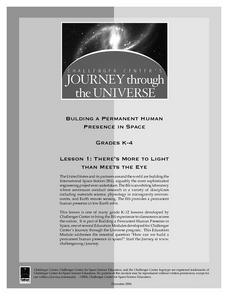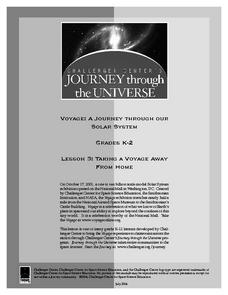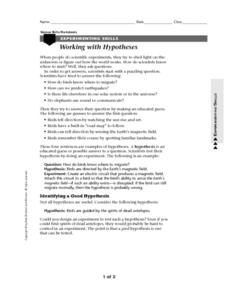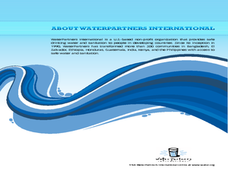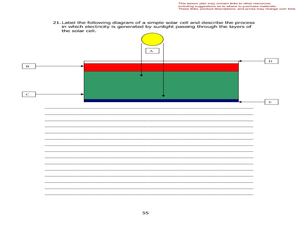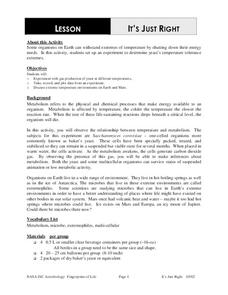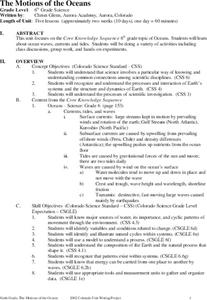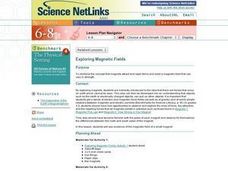Curated OER
Meteorites
Students model how meteors fall to the surface of planets. In this space science lesson, students identify different types of meteorites using an interactive online website. They investigate the relationship between a meteorite's size...
Curated OER
Water
Students conduct a series of investigations on the unique properties of water. In this general science lesson, students explain what causes water's surface tension. They explain the different stages in the water cycle.
Curated OER
Three Clouds Activity
Students understand how clouds are formed. In this cloud lesson, students participate in three experiments to make clouds. Students complete activity sheets for each experiment.
Curated OER
Solar Cycle
Students explore the solar cycle through a series of experiments. In this space science lesson, students construct and evaluate solar cycle graphs. They explain how this phenomenon affects the Earth.
Curated OER
Carbon Dioxide
Students conduct a series of experiments to explore carbon dioxide properties. In this chemistry lesson plan, students explain the production and uses of this gas. They measure its amount in soda and waste product of yeast.
Curated OER
There's More to Light than Meets the Eye
Students explore the concept that not all light is visible to the
human eye. Although UV light is not visible, it can still be harmful, causing sunburns or skin cancer. They use special beads to detect UV light around the school....
Curated OER
Taking a Voyage away from Home
Students experience and participate in a journey through a "Voyage" exhibition of the Solar System and the frontier it covers. They build a dynamic model of the Earth and Sun. Descriptions are given on the relative sizes of the Sun and...
Curated OER
What Causes the Seasons?
Middle schoolers conduct experiment to examine how tilt of globe influences warming caused by lighted bulb. They monitor simulated warming of their city by sun in winter and in summer by using light bulb, interpret results, and submit...
Curated OER
Working With Hypotheses
In this science worksheet, students examine the topic in order to solidify knowledge covered in the curriculum using puzzles and creative games.
Curated OER
How Pollution Disrupts Our Natural Environment
Students conduct experiments to illustrate global warming. In this air pollution lesson, students first examine how a layer of greenhouse gasses might impact the earth's atmospheric temperature, then evaluate how the layer of gasses...
Curated OER
Walking For Water
Young scholars investigate how third world countries get their water. In this water instructional activity, students research how countries like Kenya and Ethiopia get their water supply. Young scholars participate in an experiment to...
Curated OER
Photovoltaics and Solar Energy
Students experiment with photovoltaic cells and determine the energy use of their appliances. In this renewable energy lesson plan, students calculate the energy emitted by a photovoltaic cell through an inquiry-based lab. They keep...
Curated OER
A New Slant On The Seasons
Students identify how the tilt and position of the Earth causes the seasons. After a discussion of the seasons and when they begin. Using themselves as the objects in the universe, they role play how the rotational movement of the...
Curated OER
It's Just Right
Young scholars conduct an experiment to determine the temperature tolerance of yeasts. In this biology lesson plan, students collect data and compare them by plotting graphs. They explain how extreme temperatures affect organisms.
Curated OER
The Motions of the Oceans
Students examine the topics of ocean waves, currents, and tides. They locate and label ocean currents on a world map, conduct experiments, analyze key vocabulary, view demonstrations and record the data, and complete handouts.
Curated OER
TRB 5:2 - Activity 3: Earthquakes
Students watch a classroom demonstration, and experiment to discover the five ways that Earth's crust shifts along a fault.
Curated OER
Seasons
Students investigate the reason for seasons on Earth during three activities. They construct a model of the Earth and Sun to identify patterns in the changes of the angle of light on the Earth's surface. Then they conduct a heat...
Curated OER
Physics: Bounce - Projectile Motion and Collisions
Students conduct and observe experiments in Newtonian mechanics, kinematics, and projectile motion. They analyze the motion of a ball rolling off a table, falling, and then bouncing. Students answer a series of questions analyzing the...
Curated OER
Photosynthesis
Learners conduct a variety of experiments on photosynthesis. In this biology activity, students identify the factors required for the process to occur. They perform computerized experiments to test the amount of oxygen produced when...
Curated OER
Why Do We Have Night?
Learners engage in a fun, creative way to discover how the Earth moves. This lesson helps students explain why there is day and night. It can also create curiosity to further study the solar system and eclipses!
Curated OER
Exploring the Moon
First graders complete an experiment illustrating why the moon appears to change over time using a flashlight and ball. Students discuss the shape of the moon and identify it as a sphere. Students write a short informational piece after...
Curated OER
Plant Transpiration
Students conduct various experiments to investigate plant transpiration. In this biology instructional activity, students explain how this process helps maintain the hydrologic cycle. They measure the rate of water loss in plants using a...
Curated OER
The Discovery of OXygen
Students conduct experiments to identify the different properties of oxygen. For this chemistry lesson, students examine its importance to life on Earth. They explore the historic dispute about oxygen's discovery.
Curated OER
Exploring Magnetic Fields
Students explore the concept that magnets attract and repel items and exert a magnetic field that can vary in strength. They see evidence of the magnetic field of a small magnet. They see that there are forces on earth which cannot be seen.







